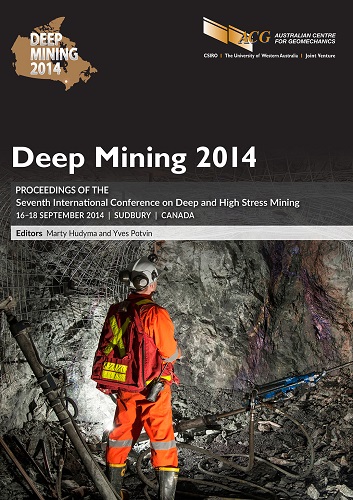Practical applications of a rockburst database to ground support design at LaRonde Mine

|
Authors: Turcotte, P |
DOI https://doi.org/10.36487/ACG_rep/1410_03_Turcotte
Cite As:
Turcotte, P 2014, 'Practical applications of a rockburst database to ground support design at LaRonde Mine', in M Hudyma & Y Potvin (eds), Deep Mining 2014: Proceedings of the Seventh International Conference on Deep and High Stress Mining, Australian Centre for Geomechanics, Perth, pp. 79-91, https://doi.org/10.36487/ACG_rep/1410_03_Turcotte
Abstract:
Agnico Eagle’s flagship LaRonde Mine is exploiting a world class Au-Ag-Cu-Zn massive sulphide lenses complex. It is located in the Abitibi Region of northwestern Quebec, approximately 650 km northwest of Montreal. With more than 4 m oz of gold in proven and probable reserves, LaRonde has one of the largest gold deposits of any mine operating in Canada. These reserves extend from surface down to 3,110 m and remain open at depth. LaRonde's ore production is around 6,300 t per day with the current mining operations taking place at 2,930 m below surface. Seismicity has been recorded at LaRonde Mine since 2004. Seismic events have caused damage to the underground excavations but have not resulted in personnel injury. This paper presents a critical review of the reported rockburst damage and how this information was used in adapting the ground support design for LaRonde. The use of the LaRonde rockburst database along with the mine seismic history has led to a more reliable evaluation of the seismic risk for specific excavations. This has led to a proactive strategy of upgrading ground support prior to the occurrence of significant seismic events in areas of concern.
References:
Agnico Eagle Mines Ltd. 2014, Agnico Eagle reports fourth quarter and full year 2013 results - Strong operational performance yields record annual production, Agnico Eagle Mines Ltd., Toronto, viewed 11 May 2014,
Heal, D, Potvin, Y & Hudyma, M 2006, ‘Evaluating rockburst damage potential in underground mining’, in DP Yale (ed.), Proceedings of the 41st U.S. Symposium on Rock Mechanics (Golden Rocks 2006): 50 Years of Rock Mechanics – Landmarks and Future Challenges, vol. 2, American Rock Mechanics Association, Alexandria, pp. 1221-1232.
Kaiser, PK, McCreath, DR & Tannant, DD 1996, Rockburst Support Handbook, Geomechanics Research Centre, Laurentian University, Sudbury.
Mercier-Langevin, F & Hadjigeorgiou, J 2010, ‘Towards a better understanding of squeezing potential in hard rock mines’, Mining Technology Journal, vol. 120, no. 1, pp. 36-44.
Mercier-Langevin, F & Turcotte, P 2007, ‘Evolution of ground support practices at Agnico Eagle’s LaRonde Division: innovative solutions to high stress yielding ground’, in E Eberhardt, D Stead & T Morrison (eds), Proceedings of the 1st Canada-US Rock Mechanics Symposium, Taylor & Francis, pp. 1497–1504.
Ortlepp, WD 1997, Rock Fracture and Rockbursts: an illustrative study, Monograph Series M9, South African Institute of Mining and Metallurgy, Johannesburg.
Simser, BP, Andrieux, P, Mercier-Langevin, F, Parrott, T & Turcotte, P 2007, ‘Field behaviour and failure modes of modified conebolts at the Craig, LaRonde and Brunswick mines in Canada’, Challenges in Deep and High Stress Mining, Australian Centre for Geomechanics, Perth, pp. 347–354.
Turcotte, P 2010, ‘Field behaviour of hybrid bolt at LaRonde Mine’, in M Van Sint Jan & Y Potvin (eds), Proceedings Fifth International Seminar on Deep and High Stress Mining, Australian Centre for Geomechanics, Perth, pp. 309-319.
© Copyright 2025, Australian Centre for Geomechanics (ACG), The University of Western Australia. All rights reserved.
View copyright/legal information
Please direct any queries or error reports to repository-acg@uwa.edu.au
View copyright/legal information
Please direct any queries or error reports to repository-acg@uwa.edu.au